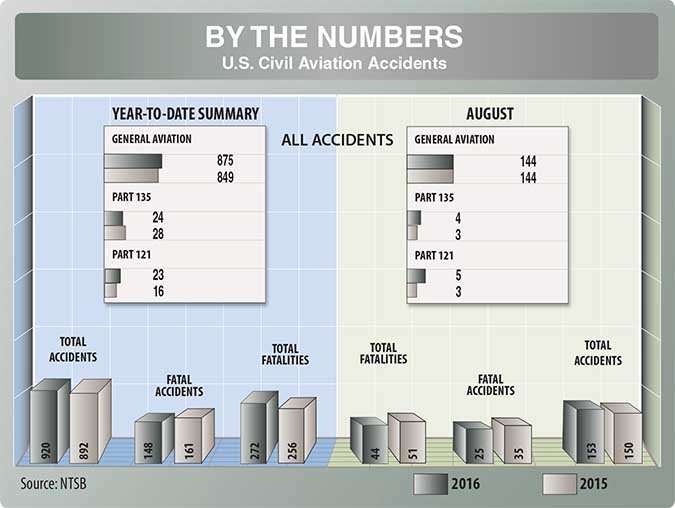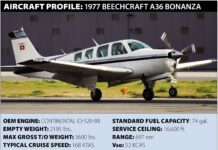September 2, 2016, Viborg, S.D.
Van’s RV-6 Experimental
At about 1000 Central time, the airplane impacted a corn field. The commercial pilot and passenger were fatally injured; the airplane was destroyed. Visual conditions prevailed.
Except for the main wreckage area, there was no noticeable damage to the field’s corn stalks. The cockpit, engine cowling and a majority of the fuselage were consumed by fire, although the wings and empennage were mostly intact. Witnesses reported hearing the engine “sputtering,” and then heard a “thud” and saw a fireball. They did not observe the airplane in the air.
September 3, 2016, Moss Hill, Texas
Bellanca 7ECA Citabria
The airplane impacted a river at about 1900 Central time. The pilot and passenger sustained fatal injuries. The airplane was substantially damaged. Visual conditions prevailed.
Ground-based video footage depicted the airplane flying over the river at low altitude. The airplane then pitched up and entered a steep climb. As the airplane reached the top of the climb, it yawed left, entering a near-vertical descent and gradual left turn. Shortly before impacting the river, the gradual left turn reversed abruptly into a right, descending turn. The airplane came to rest inverted and partially submerged in the river.

September 3, 2016, Cuba, N.M.
Piper PA-28-180 Cherokee 180
At about 2240 Mountain time, the airplane impacted ground obstacles and nosed over during a forced landing following a partial loss of engine power. The pilot and his passenger sustained minor injuries while the airplane was substantially damaged. Night visual conditions prevailed.
According to the FAA, the airplane lost partial engine power and the pilot elected to perform a night forced landing on a roadway. During the landing, the airplane’s wing impacted a ground obstacle, resulting in the nose-over.
September 3, 2016, Hollywood, Fla.
Cessna Model 172 Skyhawk
The airplane was destroyed when it impacted the Atlantic Ocean at about 0952 Eastern time. The private pilot and pilot-rated passenger were fatally injured. Visual conditions prevailed.
While transitioning along the shoreline, the pilot contacted ATC and requested to fly below 500 feet agl. The controller approved the request, advising the pilot of “heavy precipitation at the 12 o’clock position and four miles ahead.” The controller further stated, “You should turn left and go offshore three miles to avoid the thunderstorm.” The pilot acknowledged the communication by stating “roger.” Three minutes later, the pilot reported, “I am turning back to the north.” No further communications were received from the accident airplane.
The wreckage was subsequently located about two miles east of the shoreline, submerged in about 15 feet of water. The airplane was recovered; its wings exhibited accordion crushing from leading edge to trailing edge.
September 7, 2016, Chariton, Iowa
Piper PA-46-310P Malibu
At about 1219 Central time, the airplane was destroyed when it impacted terrain after an inflight breakup. The solo private pilot sustained fatal injuries.
The pilot was receiving VFR flight following services while cruising at 13,500 feet msl and deviating around convective weather. Shortly before disappearing from radar, the pilot reported to ATC he was around the weather, proceeding to his destination and descending. The controller instructed the pilot to contact ATC tower personnel but received no response.
Preliminary radar data showed the airplane making a rapid descending right turn before radar contact was lost. The airplane wreckage was located about five hours later. Examination revealed the airplane impacted a mature corn field, with wing and empennage components scattered along a path about -mile long.
September 7, 2016, Carrollton, Ga.
Beech F33A Bonanza/Diamond DA20-C1
The two airplanes collided in mid-air at 1047 Eastern time while on final approach. The Beech was substantially damaged and its solo private pilot was fatally injured. The Diamond was destroyed. The the flight instructor and student pilot aboard it were fatally injured. Visual conditions prevailed.
Initial radar data indicated the Beech entered an extended downwind from the north, above and directly behind the Diamond, at a groundspeed about 50 knots faster. Initial examination of the wreckage revealed that both airplanes remained physically attached after the collision. Additional examination revealed black transfer markings on the right half of the Diamond’s elevator consistent in color and tread pattern with the right main landing gear tire of the Beech. Other pilots in the area, flying airplanes from the same operator as the Diamond, heard the Diamond crew reporting their position and intentions on the CTAF. The Beech pilot did not appear to be broadcasting on the CTAF. The CTAF communications were not recorded.
September 9, 2016, Kodiak, Alaska
de Havilland DHC-2 Beaver
At about 1130 Alaska time, the float-equipped airplane sustained substantial damage during a collision with water, following a loss of control shortly after takeoff. The commercial pilot and two passengers sustained serious injuries. Visual conditions prevailed for the scheduled Part 135 commuter flight.
Witnesses reported the accident airplane’s takeoff run was to the west, toward an area of rising, tree-covered terrain. After the airplane became airborne, it began a gradual left turn to avoid the rising terrain ahead. As the airplane flew closer to the rising terrain, the left turn steepened and the airplane began a steep nose-down descent. The airplane subsequently struck shallow water and came to rest partially submerged. The airplane sustained substantial damage to its wings and fuselage. The witnesses reported gusty wind conditions, from the west, estimated to be between 15 to 25 knots.
September 9, 2016, Wickenburg, Ariz.
Cessna 310N
The airplane struck a refuse transfer trailer at about 0700 Mountain time, shortly after takeoff. The airline transport pilot and three passengers were seriously injured, and the airplane sustained substantial damage. Visual conditions prevailed.
Witnesses observed the airplane take off, then veer to the right of centerline shortly after rotation. The airplane climbed no higher than about 75 feet agl, and flew toward an adjacent industrial park. A few seconds later, the airplane rolled almost 90 degrees to the right and its right wing struck the trailer. The right wing separated from the airframe, and the main fuselage came to rest about 75 feet downrange.
September 10, 2016, Anchorage, Alaska
Polar Cub Experimental
At about 1630 Alaska time, the float-equipped airplane was destroyed following a loss of control and subsequent impact with tree-covered terrain. The pilot was fatally injured; a post-crash fire incinerated the airplane. Visual conditions prevailed.
Witnesses observed the accident airplane complete two, low-level, high-speed, 360-degree right turns over a neighborhood. The first 360-degree turn was accomplished at between 150 and 200 feet agl, but the second pass was much lower. The witnesses also reported the accident airplane’s bank angle increased significantly in the second 360-degree right turn. As the airplane completed the second turn, its nose pitched down and it began a rapid nose-down descent. The wings rolled level just before impacting a stand of tall trees adjacent to a home. The airplane came to rest inverted; a post-crash fire erupted about 30 seconds after impact and quickly engulfed the airplane.
September 11, 2016, Reno, Nev.
Piper PA-28R-201T Arrow IV
The airplane collided with vehicles in an airport parking lot at 1813 Pacific time, shortly after takeoff. The private pilot and two passengers were fatally injured; the airplane sustained substantial damage. Visual conditions prevailed; an IFR flight plan had been filed.
Witnesses observed the airplane climb to about 200 feet agl before leveling off. It then began to veer right of the centerline. About 90 seconds after giving the takeoff clearance, the tower controller asked the pilot, “…are you okay?” The pilot responded, “Negative; we got ah, we got a problem.” The airplane then began a descending right turn back toward the airport. About 600 feet before reaching the main terminal ramp, its right wing struck a lamp post in a long-term parking lot. The outboard section of the wing separated and the airplane immediately rolled right, striking parked automobiles and the ground.
September 16, 2016, Lancaster, Penn.
Cessna P210N Pressurized Centurion
At 1105 Eastern time, the airplane was substantially damaged following collapse of its main landing gear during landing. The flight instructor and pilot receiving instruction were not injured. Visual conditions prevailed.
As the training session was ending, the pilot receiving instruction lowered the landing gear as the airplane entered the traffic pattern. Both pilots twice confirmed the landing gear was in the down and locked position. During landing, the airplane touched down, then momentarily lifted off again. As it did so, the landing gear warning horn sounded. The flight instructor then took the controls and set the airplane down on its right main landing gear. As the airplane decelerated, the nose wheel touched down and a right yaw developed; the left wing settled onto the runway and the airplane slid to a stop. Examination revealed the airplane came to rest upright on its left wingtip, fuselage and nose wheel. Both main landing gear were collapsed and near their respective “up” positions. The nose gear was in the down position and canted to the right. A set of two tire marks about 350 feet long was found on the runway extending west from the airplane toward the approach end of the runway.
September 17, 2016, Broadus, Mon.
Beech Model 95-B55 (T42A) Baron
The airplane impacted terrain at about 1300 Mountain time. The airline transport pilot and two passengers were fatally injured, and the airplane sustained substantial damage.
All major components were identified at the accident site. Both the left and right fuel tanks had been breached but the odor of 100LL fuel was evident. The left propeller blades had displayed light chord-wise scratches. The right propeller blades had no such scratches.
September 17, 2016, Gilbert, Ariz.
Cessna Model 182P Skylane
At about 1918 Mountain time, the airplane was destroyed when it impacted a residential structure following an inflight fire. The commercial pilot was seriously injured; the four skydivers sustained minor injuries. One of the two occupants of the house sustained a minor injury. Visual conditions prevailed.
The airplane was participating in an aerial pyrotechnic display with skydivers. As the airplane arrived at the planned jump area, there was a loud noise and damage to the airplane’s left wing. The skydivers jumped out of the airplane as its left wing became engulfed in flames. The pilot radioed a distress call and then egressed. The airplane subsequently impacted a residential area. The airplane struck the house’s roof. Fire consumed a majority of the airplane and the home’s interior.



